Posted by Elena del Valle on January 28, 2013
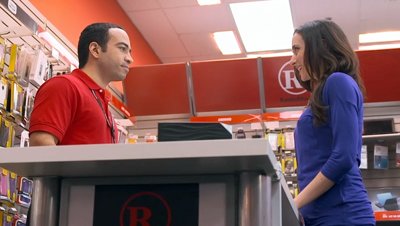
Radio Shack Spanish language TV ad targets 18-34 tech savvy shoppers
Photos, video: Radio Shack, Wing
This month Radio Shack with the help of Wing, its Hispanic market agency, ran four new Spanish-language TV spots hoping to attract Spanish speaking men and women aged 18 to 34 “that are tech savvy and actively upgrade their products and choose brands based on looks and features, not durability.” The customer the ads are for, according to a spokesperson, “wants to be the first one to have the newest, coolest products and aspires to be a trendsetter.” Scroll down to watch two ads in Spanish.
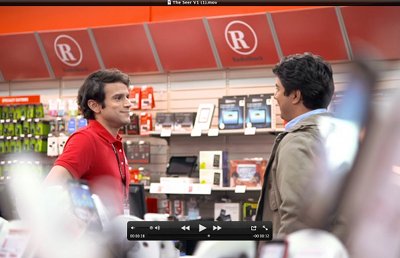
The ads were produced in Westchester, New York
Produced for less than one million dollars in Westchester, New York in December 2012 from English language originals the ads strive to convey the concept of “matching technology to your life,” to communicate how fast technology is changing and “show that Radio Shack is the personal technology store that knows their consumer,” and portray the store clerk as a knowledgeable hero.
The ads ran until Saturday January 26, 2013 in ESPN Desportes, Univision, Galavision, Telefutura, MUN2, and Telemundo. Online, they ran as ad pre-roll before editorial videos on Radio Shack’s YouTube page and Hulu. The Sad Girl ad (below), created to promote the company’s Accessory Central store, focuses only on the range of cases available to the consumer. The Seer ad (below), featuring various accessories available at Accessory Central designed to enhance the consumer’s music experience, should air again between February 24 and March 16 of this year. Team members for the project include: Renata Florio, chief creative officer; Alvaro Naddeo, art director; Facundo Paglia, copywriter; Tania Salter and Keyla Hernandez, producers; Shooters, Inc. as the production company; and Steve Williams, director.
Comments:
Filed Under: Video
Posted by Elena del Valle on January 25, 2013
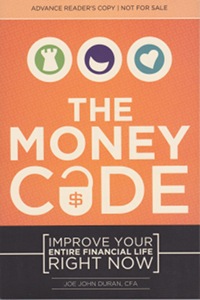
The Money Code
After finding what he thought was “the pinnacle of the American dream” Joe John Duran, a financial planner originally from Rhodesia (now Zimbabwe), realized that instead of finding freedom from money he was becoming enslaved by it. This caused him to seek change and evolved thinking. He believes decisions about money are usually emotional and affected by people’s personal histories and way of looking at things which in turn affect how they make decisions and the quality of those decisions. To obtain financial success it is necessary, according to him, to separate emotional and logical motivation.
In The Money Code: Improve Your Entire Financial Life Right Now (Greenleaf Book Group Press, $14.95) he outlines the path, he believes, leads to lasting financial solutions; a way to pass from what people say they want to what they are doing to get there. He sets out to help readers discover their attitudes toward money and identify a “road map for making sound financial decisions.” He proposes that money serves three main purposes: avoidance of pain by protecting what a person values in the future, feeling good by facilitating access to things that make a person happy, and providing the means to help others.
In the 155-page softcover book, he presents his five Money Secrets: tough choices are part of life, how someone makes decisions determines his entire life, a person’s biases affect every decision he or she makes, inconsequential distractions come along, and a good process is required to make good decisions. He relies on hypothetical situations, a fictional character and check-lists to illustrate his points in eleven chapters.
Duran, founding partner of United Capital, a wealth counseling firm, previously served as president of GE Private Asset Management. He holds the Chartered Financial Analyst (CFA) designation and earned MBA degrees from Columbia University and UC Berkeley. The the author of two other books, he lives in Laguna Beach, California, with his wife and daughters.
Comments:
Filed Under: Books
Posted by Elena del Valle on January 18, 2013

Re-enactment photo: an actress portrays Apolinaria Lorenzana, a young orphan brought into a Spanish settlement in California in 1811*
Photos: Brett Buchanan Photography, 2012
Latin Americans, a three-part, six-hour documentary series said to “chronicle the rich and varied history and experiences of Latinos, who have helped shape the United States over the last 500-plus years,” is expected to air nationally on PBS this fall. Actor Benjamin Bratt will narrate, Joseph Julián González will compose the musical score, and Lila Downs will be the featured artist for the series, performing the closing song. The program features interviews with one hundred Latinos in politics, business and pop culture including Rita Moreno, Dolores Huerta, Linda Chávez, and Gloria Estefan.
Other interview subjects are María Elena Salinas, co-anchor of Noticiero Univision; Juan Gonzalez, author of Harvest of Empire: A History of Latinos in America and co-founder of the Young Lords Organization, a Puerto Rican nationalist movement; Rep. Charles Gonzalez, a retired Texas congressman who from 1999-2012 served in the House of Representatives for the district that his father, Henry B. Gonzalez, represented for nearly four decades; and Herman Badillo, the Bronx politician who, in 1970, became the first Puerto Rican elected to the House of Representatives and ran six times for mayor of New York.
The staff completed the interviews and other shooting and are now finishing post-production, including final editing, narration recording, music scoring, audio mixing, color correction and packaging. Between pre-production, production and post-production, the entire series will take 18 months to complete. A spokesperson indicated via email, “… we expect to have our finished series in March 2013, ahead of the Fall 2013 broadcast premiere.”
The six segments of the series are in chronological order: Strangers in Their Own Land, from 1500-1880; The Pull and the Push, between 1880 and the 1940s; War and Peace, from the World War II years; The New Latinos, from the post-World War II years into the early 1960s; Pride and Prejudice; and Peril and Promise, over the past 30 years.
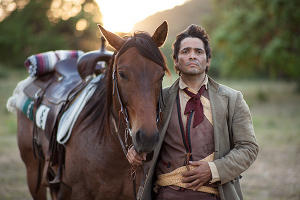
Re-enactment photo: An actor portrays Juan Seguín, a political and military figure of the Texas Revolution and Republic of Texas.**
More than two dozen people worked on the series, a production team for each of the six hours, who shot in various places around the country; a production team with Bosch and Company, Inc. in Boston; and the team at WETA Washington, D.C. There are re-enactments in the two first hours of the series, depicting scenes with historical characters such as Apolinaria Lorenzana and Juan Seguín, figures from the 19th Century.
The scenes for Lorenzana, a young orphan who Spanish representatives brought into the Spanish settlement in California in 1811, were shot on-location at Mission San Francisco de la Espada (Espada Mission) in San Antonio, Texas. The scenes for Seguín, a political and military figure of the Texas Revolution and Republic of Texas, were shot on-location at Northrup Pipe Creek Ranch in Lakehills, Texas. Other historic characters brought to life through dramatic re-enactments include Mariano Guadalupe Vallejo, a Californian military commander, politician, and rancher; and Juan Salvador Villasenor, whose family fled the Mexican Revolution. The production team shot new footage for the final sixth hour of the series, of modern stories.
Funding for the program was provided by Corporation for Public Broadcasting (CPB), Public Broadcasting Service (PBS), Ford Foundation, National Endowment for the Humanities, The Rockefeller Foundation, The Arthur Vining Davis Foundations, Latino Public Broadcasting (LPB) and The Summerlee Foundation. The series is a production of WETA Washington, DC; Bosch and Co., Inc.; and Latino Public Broadcasting (LPB). The executive producers are Jeff Bieber and Dalton Delan for WETA, and Sandie Viquez Pedlow for LPB. Adriana Bosch, a Cuban-born filmmaker whose previous PBS projects include Latin Music U.S.A. and documentaries on Presidents Dwight Eisenhower, Jimmy Carter, Ronald Reagan and Fidel Castro, is the series producer.
Plans are for the series to be accompanied by a bilingual public education campaign, a bilingual website with user-generated digital content, social media platforms and the development of a school-based curriculum. A companion book by Ray Suarez, senior correspondent, PBS Newshour, will be published by Celebra, and is expected to be released in conjunction with the broadcast premiere.
*Shot on-location for Latino Americans at Mission San Francisco de la Espada (Espada Mission) in San Antonio, Texas. **Shot on-location for Latino Americans at Northrup Pipe Creek Ranch in Lakehills, Texas.
Posted by Elena del Valle on January 18, 2013
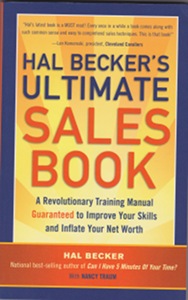
Hal Becker’s Ultimate Sales Book
Hal Becker, once the top salesman out of a salesforce of 11,000 at Xerox, and now a consultant, with Nancy Traum, president and chief executive officer, Solon Chamber of Commerce, published Hal Becker’s Ultimate Sales Book (CareerPress, $15.99) last year. In the 254-page softcover book written to be a “sales book and a sales training course rolled into one,” they outline ideas to assist readers in improving their sales skills.
Chapters address: What Great Salespeople Know; The Importance of Listening; Preparing for the Sales Call; The Importance of Questions; Increasing Your Sales; Cold Calls, Phone Selling and Other Contact Options; Time Management; Handling Objections; Closing the Sale; Customer Care; Role-Playing; and You’ve Earned a Bonus. The chapters feature lessons and quizzes.
In his opinion, a good sales person prepares to start selling once he or she meets with their customer while a great salesperson prepares for the sale in advance of the meeting. Preparing for a sale or negotiation is important, he stresses in Lesson 10. “The more prepared you are, the better your chance for success,” he says. In that lesson he suggests reviewing goals, making sure to have notes ready, paying attention to a prospective client’s office, being real and leaving cell phones and electronic devices behind to avoid being distracted during the meeting.
According to promotional materials, Becker conducts seminars or consults for 140 organizations a year, including IBM, Disney, United Airlines, and AT&T. He is the author of Can I have 5 Minutes Of Your Time?, Lip Service, and Get What You Want.
Comments:
Filed Under: Books
Posted by Elena del Valle on January 14, 2013
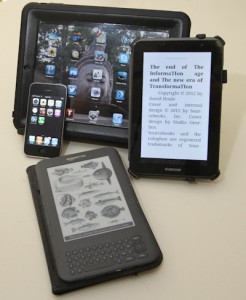
23 percent said they read ebooks
Photos: HispanicMPR
Selling a book? Thinking of becoming an author? You may be in luck. It seems many Americans are reading books. Whether it’s printed books, purchased or borrowed e-books (from the library) reading is popular. At the end of last year, 75 percent of Americans 16 and older said they read books, according to a Pew Research Center’s Internet & American Life Project phone survey of 2,252 people 16 years and older, and a related article by Lee Rainie and Maeve Duggan. Those numbers represent a 3 percent decline compared to 2011 when 78 percent of survey takers said they read books.
A closer look reveals an increase in e-book readers with 23 percent of survey takers 16 and older saying they read e-books, up from 16 percent the previous year; and 13 percent of them said they had listened to an audio book. It’s no wonder since the percent of survey takers who own a book reading device (tablet, computer or e-book reader) went from 18 percent in 2011 to 33 percent in 2012.

14 percent said they read 21 or more books
The increase in e-book readers between 2011 and 2012 was 11 percent among non Hispanic blacks, 10 percent among non Hispanic whites and 5 percent among Hispanics. Print book reading dropped from 72 percent to 67 percent over the same time period, according to the same Pew data.
In the past year, 7 percent of survey takers said they had read one book; 12 percent said they had read four to five books; 13 percent said they had read eleven to twenty books; and 14 percent indicated they had read 21 or more books. The mean number of books read by women was 17 compared to 13 by men. The most likely e-book readers? People between 30 and 49 with college or graduate degrees and those who live in households with an income of more than $75,000.
Posted by Elena del Valle on January 11, 2013
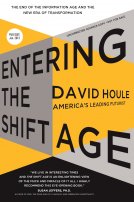
Entering the Shift Age
Photo: Sourcebooks
In his most recent book David Houle, a self described futurist, examines the historic transformation of humans. He explains that our society has been transformed by a series of eras each with its own characteristics. First, the Agricultural Age brought about organized cultivation and permanent settlements in lieu of the nomadic lifestyle humans had had for thousands of years. He discusses how the Industrial Revolution led to yet other dramatic changes in the world; and most recently the Information Age transformed work and personal environments in the United States and later internationally with record speed. He is convinced that now we are in a new era which is having a dramatic impact on society.
Houle, author, Entering the Shift Age The End of the Information Age and the New Era of Transformation (Sourcebooks, $8.69), a soon to be published e-book of 3,431 tablet length pages, believes we left the Information Age behind in 2006 following the Threshold Decades and transitioned quietly to what he calls the Shift Age which is still being created and defined by three dominant forces: the Flow to Global, the Flow to Individual and Accelerating Electronic Connectedness.
People will arrive at a point where they will consider that they are part of a global community, rather than an international one, he points out in Chapter Three. This is due in part because the speed of communications has shrunk the world, opened borders driving world politics inward and increasing multicultural integration, he explains in the book.
Houle is convinced that during the Shift Age a greater number of people will migrate than during previous ages in part because there are more people and in part because a higher percent of the population will migrate. At the same time, due to the global economy, he says in Chapter Twenty-Seven, “increasingly we will look globally for employment or contract work.” In the future, people will work together in project and then separate.
Millenials he has met have a strong desire to experience the world, planning to spend up to ten years working at various places around the globe. Digital Natives are ever more interconnected into the global community, he says. They are the group with least place-base identity. Africa is poised to enter a golden age in 2020 and such a boom will impact mass migration, he says toward the end of the book.
While the book was legible in a tablet the formatting was riddled with odd line breaks, some words with a random mix of lowercase and uppercase letters that did not follow a standard publishing style, and hard to read figures due to the odd formatting display on the tablet screen.
Houle, a strategist and keynote speaker, won a Speaker of the Year award from Vistage International. According to his biography, he has spoken to or advised more than two thousand chief executive officers and business owners in the past four years.
Comments:
Filed Under: Books
Posted by Elena del Valle on January 7, 2013

Sales of smoking cessation products may increase 3 percent from 2011-12 and reach $1 billion and growth is expected through 2017 reaching $1.2 billion in sales, according to Smoke Cessation Products US December 2012, a Mintel report. The odds of kicking the habit may be against the average smoker. According to the Mayo Clinic website, only 5 percent of people who try to quit tobacco succeed on their own without a quit-smoking product. The site indicates more than 30 percent “can succeed when using a quit-smoking product.”
It seems some smokers who want to quit fear gaining weight during the quitting process. Forty one percent of respondents to a Mintel survey, conducted online in English December 2012, who have previously quit or are interested in quitting, said gaining weight was their biggest challenge to quitting smoking; 54 percent of those were women and 31 percent were men.
Hispanic respondents to the survey were more likely to smoke than other respondents. Those who smoked appeared more likely to be trying to stop. Mintel staff believes smoking cessation product marketers might consider Hispanic specific outreach.
Hispanic smokers trying to quit who responded to the survey said they were influenced by their friends in their desire to stop smoking. This led Mintel staff to suggest the possibility of marketing program activities with smokers friends.
Hispanic respondents who had quit or wanted to quit were less likely to say that they look for smoking cessation products that are not expensive. At the same time they were also less likely to say the cost of cigarettes influenced their behavior.
Posted by Elena del Valle on January 1, 2013

As the past year ends and a new one begins we take the opportunity to thank you for following our articles, podcast interviews, emails and Tweets, for sharing your comments, ideas and suggestions, and working with us to make our content interesting and relevant. And to wish you a healthy and prosperous 2013!




















